An Integrated Geologic Map of the Rembrandt Basin, on Mercury, as a Starting Point for Stratigraphic Analysis
Abstract
1. Introduction
2. Geologic Mapping Materials and Methods
2.1. Data
2.2. Geographic Coordinate System and Projections
2.3. The Choice of Two Map Layers
2.4. Mapping Scale
3. Geologic Units Description
3.1. Morpho-Stratigraphic Map Units
3.1.1. Interior Smooth Plains (ISP)
3.1.2. Exterior Smooth Plains
- 1.
- Exterior Smooth Plains (ESP). These plains appear as a smooth, lightly cratered terrain, also distinctly brighter than the surrounding material, and must have been emplaced subsequently to the basin formation (if prior, they would have been destroyed or covered by impact ejecta). As for the ISP, ESP are most probably of volcanic origin [26], showing lower crater density than their surroundings, with which they have sharp morphological boundaries. Furthermore, ESP seem to be controlled by topography, as they mainly occur in topographic lows. They are also modified by post-emplacement tectonics (wrinkle ridges).
- 2.
- Exterior Intermediate Smooth Plains (EIP). These plains display a more cratered terrain and have a slightly rougher texture than all other smooth plains. They do not seem to be confined to topographic lows; instead, each deposit covers both low and high-standing topography. Additionally, EIP are modified by tectonic processes (both wrinkle ridges and lobate scarps), indicating post-emplacement modification. Due to their controversial morphological characteristics, the origin of these plains is still debated, as they could be either volcanic (similarly to the ESP) or impact melt [26].
3.1.3. Rembrandt Ejecta Deposits (RE)
3.1.4. Rembrandt Rough Floor Terrain (RFT)
3.1.5. Intercrater Plains (IT)
3.1.6. Crater Material
- Smooth crater floor (SCF): smooth crater infill consistent with either impact melt or post-impact volcanism and confined within the crater. They have similar texture compared to that of the smooth plains (interior and exterior).
- Hummocky crater floor (HCF): rough crater infill, including all material reworked during the impact. Very similar texture to that of the IT.
3.1.7. Main Tectonic Features
3.2. Geo-Stratigraphic Map Units
3.2.1. Interior Smooth Plains
3.2.2. Exterior Smooth Plains
- High-reflectance exterior smooth plains (PrH). These plains appear distinctly as the brightest examples, with a similar tone to the youngest smooth plains inside the Rembrandt basin. PrH are also the smoothest and least cratered terrain found in the mapping area. As such, they can be considered the youngest event outside the basin. These plains are most likely to be related to a volcanic origin [26] (for the morphological characteristics, see ESP in the morpho-stratigraphic map).
- Low-reflectance exterior smooth plains (PrL). These plains are characterized by the darkest tone (in some places even similar to the low-reflectance material—see below) and are more heavily cratered than other smooth plains. These plains were attributed to impact melt by [26] (for the morphological characteristics, see EIP in the morpho-stratigraphic map). In the south-west portion of the basin, this material extends within the basin rim, suggesting that some impact melt might have been emplaced inside the basin, as well.
- Intermediate-reflectance Exterior Plains (PrI). We distinguished two additional plain units with different colors and albedo with respect to PrH and PrL. These plains, diverse in color and brightness one to each other, show an intermediate crater density with respect to the two end members. Therefore, from crater density and overlapping relationship, we can recognize the following stratigraphic sequence, from younger and brighter to older and darker units: PrH, PrI1, PrI2, PrL.
3.2.3. Intercrater Plains (IT)
3.2.4. Low-Reflectance Material (LRM)
3.2.5. Crater Material
4. Thickness Estimated and Infilling History of the Rembrandt Basin
4.1. Spectrally Distinct Ejecta as Indicators of Maximum Thickness of Smooth Plains
4.2. Measured vs. Predicted Rim Height of Embayed Craters as Thickness Estimates of Shallow Layers
4.3. Crater Counting for Dating and Surface Layering Thickness Estimates
- The age of 3.8 ± 0.1 Ga (Figure 11a) is likely to be associated with RFT, mapped and interpreted as the bottom layer within the basin, i.e., a mixture of LRM and IT reworked in the early stages after the impact event and before the emplacement of the smooth plains. Therefore, this age can be related to the Rembrandt basin impact event, being also consistent with previous works [24,25].
- Secondly, we link the age of 3.7 ± 0.1 Ga (Figure 11b) to the emplacement of the first smooth plain event, i.e., the OIP: although this value falls within the fit error of the previous age, the two different fits are separated by a visible S-shape kink that occurs between 30–45 km.
- Lastly, CSFD for craters with diameter <10 km resulted in ambiguous age assessments:
- a.
- The Hard-Rock scaling law (Figure 11c) suggests the presence of a resurfacing event, significantly distinct in terms of age from the OIP and indeed possibly associated with the YIP of 2.3 ± 0.3 Ga.
- b.
- Using the Cohesive Soil scaling law (Figure 11d), which is consistent with fractured material (i.e., breccias) expected for smaller crater sizes [81], the resulting CSFD at craters <10 km returns an age of 3.7 ± 0.1 Ga. This suggests a continuity in the filling process of smooth plains within the basin, being the same age of 3.7 ± 0.1 Ga for all craters with diameter <30 km. According to this interpretation, the YIP and OIP (well visible in the geo-stratigraphic map) are not separable in terms of model age, since they pertain to two phases of the same infilling event developed in the time bracket of the model-age error bar (i.e., 100 Ma).
4.4. Volume Estimate of the Basin Infilling
5. Discussions
- The Intercrater plains (IT) and the Low-Reflectance Material (LRM) of the geo-stratigraphic map, attributed to the pre-Tolstojan and Tolstojan age [19], correspond in the morpho-stratigraphic map to the Intercrater plains (IT) as well as the ejecta (RE) and rough floor (RFT) of the Rembrandt basin. It is worth recalling here that while the pristine IT are thought to pre-date the Rembrandt basin impact, the LRM has been interpreted as uplifted basin floor material from lower crust or upper mantle [22,26] or crystallized (and differentiated?) impact melt [88], so it can be either related to the impact or pre-date it. However, in our geo-stratigraphic map and chart we have specifically distinguished the following materials:
- a.
- Autochthonous pre-impact material (IT and LRM)
- b.
- Syn-impact para-autochthonous material (uplifted but not detached) (IT-pa and LRM-pa—which are associated with the RFT in the morpho-stratigraphic map)
- c.
- Post-impact material, reworked by the Rembrandt impact itself (IT-r and LRM-r)
- d.
- Material reworked by subsequent impact craters (IT-r2 and LRM-r2)
- 2.
- The smooth plains are broadly unified in three large units within and outside the basin in the morpho-stratigraphic map, whereas they are subdivided into several emplacement events in the geo-stratigraphic map. Within the geo-stratigraphic map, in particular, we distinguished two different smooth plain units inside the Rembrandt basin, associated with two different volcanic resurfacing events that occurred after the impact basin. Model-age results for the younger smooth plains (YIP) suggest either early-Calorian or mid-Calorian age (considering the age boundaries proposed by [87]), using respectively the Cohesive Soil or Hard-Rock production function for smaller craters. Analysis of the S-shaped kinks obtained by using the Hard-Rock production function returned thickness estimates consistent with those derived by independent methods (see Section 4) and thus the mid-Calorian age seems more reliable. This means that the volcanic activity within the Rembrandt basin would have been maintained much longer (up to 2.3 Ga instead of 3.5 Ga) than generally thought for most of the Mercury surface (e.g., [8]) being coeval to the younger volcanism up to date documented only in a few other minor basins [89].
- 3.
- Our volume estimate of the entire Rembrandt infilling is around 2.5–3.7 × 105 km3. This is appreciably lower than that of the larger Caloris basin, which was flooded by a volume ranging between 3.2 and 5.2 × 106 km3 [22]. It is thus reasonable that the first lava infilling of the two basins was of similar early-Calorian age [4,21,25], but the volume of lava infilling much greater in Caloris than in Rembrandt.
- 4.
- The crater deposits are considered in totally different ways in the morpho-stratigraphic and geo-stratigraphic maps. The former is more informative about their relative age, constrained by the degradation degree, whereas the latter attempts to distinguish the original source of their materials. How best to combine these two types of information is still to be evaluated in function of map readability and purpose.
6. Conclusions
Supplementary Materials
Author Contributions
Funding
Acknowledgments
Conflicts of Interest
References
- Hargitai, H. Planetary Cartography and GIS; Springer International Publishing: Berlin/Heidelberg, Germany, 2019. [Google Scholar]
- Spudis, P.D.; Guest, J.E. Stratigraphy and geologic history of Mercury. In Mercury; University of Arizona Press: Tucson, AZ, USA, 1988; pp. 118–164. [Google Scholar]
- Denevi, B.W.; Robinson, M.S.; Solomon, S.C.; Murchie, S.L.; Blewett, D.T.; Domingue, D.L.; McCoy, T.J.; Ernst, C.M.; Head, J.W.; Watters, T.R.; et al. The evolution of Mercury’s crust: A global perspective from MESSENGER. Science 2009, 324, 613–618. [Google Scholar] [CrossRef] [PubMed]
- Denevi, B.W.; Ernst, C.M.; Meyer, H.M.; Robinson, M.S.; Murchie, S.L.; Whitten, J.L.; Head, J.W.; Watters, T.R.; Solomon, S.C.; Ostrach, L.R.; et al. The distribution and origin of smooth plains on Mercury. J. Geophys. Res. E Planets 2013, 118, 891–907. [Google Scholar] [CrossRef]
- Rothery, D.A. Planet Mercury: From Pale Pink Dot to Dynamic World; Springer: Berlin/Heidelberg, Germany, 2014. [Google Scholar]
- Ostrach, L.R.; Robinson, M.S.; Whitten, J.L.; Fassett, C.I.; Strom, R.G.; Head, J.W.; Solomon, S.C. Extent, age, and resurfacing history of the northern smooth plains on Mercury from MESSENGER observations. Icarus 2015, 250, 602–622. [Google Scholar] [CrossRef]
- Prockter, L.M.; Head, J.W.I.I.I.; Byrne, P.K.; Denevi, B.W.; Kinczyk, M.J.; Fassett, C.I.; Whitten, J.L.; Thomas, R.J.; Ernst, C.M. The First Global Geological Map of Mercury. In Proceedings of the 47th Lunar and Planetary Science Conference, The Woodlands, TX, USA, 21–25 March 2016; Lunar and Planetary Institute: Houston, TX, USA, 2016; p. 1245. [Google Scholar]
- Byrne, P.K.; Ostrach, L.R.; Fassett, C.I.; Chapman, C.R.; Denevi, B.W.; Evans, A.J.; Klimczak, C.; Banks, M.E.; Head, J.W.; Solomon, S.C. Widespread effusive volcanism on Mercury likely ended by about 3.5 Ga. Geophys. Res. Lett. 2016, 43, 7408–7416. [Google Scholar] [CrossRef]
- Denevi, B.W.; Chabot, N.L.; Murchie, S.L.; Becker, K.J.; Blewett, D.T.; Domingue, D.L.; Ernst, C.M.; Hash, C.D.; Hawkins, S.E.; Keller, M.R.; et al. Calibration, Projection, and Final Image Products of MESSENGER’s Mercury Dual Imaging System. Space Sci. Rev. 2018, 214. [Google Scholar] [CrossRef]
- Solomon, S.C.; Nittler, L.R.; Anderson, B.J. Mercury: The View after MESSENGER; Cambridge University Press: Cambridge, UK, 2018. [Google Scholar]
- Melosh, H.J.; Dzurisin, D. Mercurian global tectonics: A consequence of tidal despinning? Icarus 1978, 35, 227–236. [Google Scholar] [CrossRef]
- Ernst, C.M.; Murchie, S.L.; Barnouin, O.S.; Robinson, M.S.; Denevi, B.W.; Blewett, D.T.; Head, J.W.; Izenberg, N.R.; Solomon, S.C.; Roberts, J.H. Exposure of spectrally distinct material by impact craters on Mercury: Implications for global stratigraphy. Icarus 2010, 209, 210–223. [Google Scholar] [CrossRef]
- Peplowski, P.N.; Lawrence, D.J.; Feldman, W.C.; Goldsten, J.O.; Bazell, D.; Evans, L.G.; Head, J.W.; Nittler, L.R.; Solomon, S.C.; Weider, S.Z. Geochemical terranes of Mercury’s northern hemisphere as revealed by MESSENGER neutron measurements. Icarus 2015, 253, 346–363. [Google Scholar] [CrossRef]
- Weider, S.Z.; Nittler, L.R.; Starr, R.D.; Crapster-Pregont, E.J.; Peplowski, P.N.; Denevi, B.W.; Head, J.W.; Byrne, P.K.; Hauck, S.A.; Ebel, D.S.; et al. Evidence for geochemical terranes on Mercury: Global mapping of major elements with MESSENGER’s X-Ray Spectrometer. Earth Planet. Sci. Lett. 2015, 416, 109–120. [Google Scholar] [CrossRef]
- Namur, O.; Charlier, B. Silicate mineralogy at the surface of Mercury. Nat. Geosci. 2017, 10, 9–13. [Google Scholar] [CrossRef]
- Bott, N.; Doressoundiram, A.; Zambon, F.; Carli, C.; Guzzetta, L.; Perna, D.; Capaccioni, F. Global Spectral Properties and Lithology of Mercury: The Example of the Shakespeare (H-03) Quadrangle. J. Geophys. Res. Planets 2019, 124, 2326–2346. [Google Scholar] [CrossRef]
- Mancinelli, P.; Minelli, F.; Pauselli, C.; Federico, C. Geology of the Raditladi quadrangle, Mercury (H04). J. Maps 2016, 12, 190–202. [Google Scholar] [CrossRef]
- Galluzzi, V.; Guzzetta, L.; Ferranti, L.; Di Achille, G.; Rothery, D.A.; Palumbo, P. Geology of the Victoria quadrangle (H02), Mercury. J. Maps 2016, 12, 227–238. [Google Scholar] [CrossRef]
- Guzzetta, L.; Galluzzi, V.; Ferranti, L.; Palumbo, P. Geology of the Shakespeare quadrangle (H03), Mercury. J. Maps 2017, 13, 227–238. [Google Scholar] [CrossRef]
- Wright, J.; Rothery, D.A.; Balme, M.R.; Conway, S.J. Geology of the Hokusai quadrangle (H05), Mercury. J. Maps 2019, 15, 509–520. [Google Scholar] [CrossRef]
- Strom, R.G.; Banks, M.E.; Chapman, C.R.; Fassett, C.I.; Forde, J.A.; Head, J.W.; Merline, W.J.; Prockter, L.M.; Solomon, S.C. Mercury crater statistics from MESSENGER flybys: Implications for stratigraphy and resurfacing history. Planet. Space Sci. 2011, 59, 1960–1967. [Google Scholar] [CrossRef]
- Ernst, C.M.; Denevi, B.W.; Barnouin, O.S.; Klimczak, C.; Chabot, N.L.; Head, J.W.; Murchie, S.L.; Neumann, G.A.; Prockter, L.M.; Robinson, M.S.; et al. Stratigraphy of the Caloris basin, Mercury: Implications for volcanic history and basin impact melt. Icarus 2015, 250, 413–429. [Google Scholar] [CrossRef]
- Murchie, S.L.; Klima, R.L.; Denevi, B.W.; Ernst, C.M.; Keller, M.R.; Domingue, D.L.; Blewett, D.T.; Chabot, N.L.; Hash, C.D.; Malaret, E.; et al. Orbital multispectral mapping of Mercury with the MESSENGER Mercury Dual Imaging System: Evidence for the origins of plains units and low-reflectance material. Icarus 2015, 254, 287–305. [Google Scholar] [CrossRef]
- Watters, T.R.; Head, J.W.; Solomon, S.C.; Robinson, M.S.; Chapman, C.R.; Denevi, B.W.; Fassett, C.I.; Murchie, S.L.; Strom, R.G. Evolution of the Rembrandt impact basin on Mercury. Science 2009, 324, 618–621. [Google Scholar] [CrossRef]
- Ferrari, S.; Massironi, M.; Marchi, S.; Byrne, P.K.; Klimczak, C.; Martellato, E.; Cremonese, G. Age relationships of the Rembrandt basin and Enterprise Rupes, Mercury. Geol. Soc. Spec. Publ. 2015, 401, 159–172. [Google Scholar] [CrossRef]
- Whitten, J.L.; Head, J.W. Rembrandt impact basin: Distinguishing between volcanic and impact-produced plains on Mercury. Icarus 2015, 258, 350–365. [Google Scholar] [CrossRef]
- Watters, T.R.; Solomon, S.C.; Robinson, M.S.; Head, J.W.; André, S.L.; Hauck, S.A.; Murchie, S.L. The tectonics of Mercury: The view after MESSENGER’s first flyby. Earth Planet. Sci. Lett. 2009, 285, 283–296. [Google Scholar] [CrossRef]
- Klimczak, C.; Byrne, P.K.; Solomon, S.C. A rock-mechanical assessment of Mercury’s global tectonic fabric. Earth Planet. Sci. Lett. 2015, 416, 82–90. [Google Scholar] [CrossRef]
- Massironi, M.; Di Achille, G.; Rothery, D.A.; Galluzzi, V.; Giacomini, L.; Ferrari, S.; Zusi, M.; Cremonese, G.; Palumbo, P. Lateral ramps and strike-slip kinematics on Mercury. Geol. Soc. Spec. Publ. 2015, 401, 269–290. [Google Scholar] [CrossRef]
- Crane, K.T.; Klimczak, C. Tectonic patterns of shortening landforms in Mercury’s northern smooth plains. Icarus 2019, 317, 66–80. [Google Scholar] [CrossRef]
- Giacomini, L.; Massironi, M.; Galluzzi, V.; Ferrari, S.; Palumbo, P. Dating long thrust systems on Mercury: New clues on the thermal evolution of the planet. Geosci. Front. 2020, 11, 855–870. [Google Scholar] [CrossRef]
- Hawkins, S.E.; Boldt, J.D.; Darlington, E.H.; Espiritu, R.; Gold, R.E.; Gotwols, B.; Grey, M.P.; Hash, C.D.; Hayes, J.R.; Jaskulek, S.E.; et al. The Mercury dual imaging system on the MESSENGER spacecraft. Space Sci. Rev. 2007, 131, 247–338. [Google Scholar] [CrossRef]
- Becker, K.J.; Robinson, M.S.; Becker, T.L.; Weller, L.A.; Edmundson, K.L.; Neumann, G.A.; Perry, M.E.; Solomon, S.C. First global digital elevation model of Mercury. In Proceedings of the 47th Lunar and Planetary Science Conference, The Woodlands, TX, USA, 21–25 March 2016; Lunar and Planetary Institute: Houston, TX, USA, 2016; p. 2959. [Google Scholar]
- Deetz, C.H.; Adams, O.S. Elements of Map Projection with Applications to Map and Chart Construction, 5th ed.; US Coast and Geodetic Survey Special Publication 68; U.S. Department of Commerce: Washington, DC, USA, 1945. [Google Scholar]
- Galluzzi, V. Multi-mapper projects: Collaborative Mercury mapping. In Planetary Cartography and GIS; Springer: Berlin/Heidelberg, Germany, 2019; pp. 207–218. [Google Scholar]
- Shoemaker, E.; Hackman, R.J. Lunar Photogeologic Chart LPC 58. Copernicus, Prototype Chart; USGS, unpublished; U. S. Air Force’s Chart and Information Center (ACIC): St. Louis, MO, USA, 1961. [Google Scholar]
- Mason, A.C.; Hackman, R.J. Photogeologic study of the Moon. Moon 1962, 14, 301–316. [Google Scholar] [CrossRef]
- Shoemaker, E.M.; Hackman, R.J. Stratigraphic basis for a lunar time scale. Moon 1962, 14, 89–300. [Google Scholar] [CrossRef]
- Tobler, W.R. Experiments in migration mapping by computer. Am. Cartogr. 1987, 14, 155–163. [Google Scholar] [CrossRef]
- Du, Q.; Younan, N.H.; King, R.; Shah, V.P. On the performance evaluation of pan-sharpening techniques. IEEE Geosci. Remote Sens. Lett. 2007, 4, 518–522. [Google Scholar] [CrossRef]
- Parente, C.; Pepe, M. Influence of the weights in IHS and Brovey methods for pan-sharpening WorldView-3 satellite images. Int. J. Eng. Technol. 2017, 6, 71–77. [Google Scholar] [CrossRef]
- Vrabel, J. Multispectral imagery band sharpening study. Photogramm. Eng. Remote Sens. 1996, 62, 1075–1083. [Google Scholar]
- Pushparaj, J.; Hegde, A.V. Evaluation of pan-sharpening methods for spatial and spectral quality. Appl. Geomat. 2017, 9, 1–12. [Google Scholar] [CrossRef]
- Watters, T.R.; Montési, L.G.J.; Oberst, J.; Preusker, F. Fault-bound valley associated with the Rembrandt basin on Mercury. Geophys. Res. Lett. 2016, 43, 11536–11544. [Google Scholar] [CrossRef]
- Watters, T.R.; Murchie, S.L.; Robinson, M.S.; Solomon, S.C.; Denevi, B.W.; André, S.L.; Head, J.W. Emplacement and tectonic deformation of smooth plains in the Caloris basin, Mercury. Earth Planet. Sci. Lett. 2009, 285, 309–319. [Google Scholar] [CrossRef]
- Trask, N.J.; Guest, J.E. Preliminary geologic terrain map of Mercury. J. Geophys. Res. 1975, 80, 2461–2477. [Google Scholar] [CrossRef]
- Murray, B.C. The Mariner 10 pictures of Mercury: An overview. J. Geophys. Res. 1975, 80, 2342–2344. [Google Scholar] [CrossRef]
- Strom, R.G.; Trask, N.J.; Guest, J.E. Tectonism and volcanism on Mercury. J. Geophys. Res. 1975, 80, 2478–2507. [Google Scholar] [CrossRef]
- Wilhelms, D.E. Mercurian volcanism questioned. Icarus 1976, 28, 551–558. [Google Scholar] [CrossRef]
- Oberbeck, V.R. Comparative studies of the Moon, Mercury and Mars. NASTM 1977, 3511, 39–41. [Google Scholar]
- Kiefer, W.S.; Murray, B.C. The formation of Mercury’s smooth plains. Icarus 1987, 72, 477–491. [Google Scholar] [CrossRef]
- McCauley, J.F.; Guest, J.E.; Schaber, G.G.; Trask, N.J.; Greeley, R. Stratigraphy of the Caloris basin, Mercury. Icarus 1981, 47, 184–202. [Google Scholar] [CrossRef]
- Kinczyk, M.J.; Prockter, L.M.; Chapman, C.R.; Susorney, H.C.M. A morphological evaluation of crater degradation on Mercury: Revisiting crater classification using MESSENGER data. In Proceedings of the 47th Annual Lunar and Planetary Science Conference, The Woodlands, TX, USA, 21–25 March 2016; Lunar and Planetary Institute: Houston, TX, USA, 2016; p. 1573. [Google Scholar]
- Kinczyk, M.J.; Prockter, L.M.; Byrne, P.K.; Susorney, H.C.M.; Chapman, C.R. A morphological evaluation of crater degradation on Mercury: Revisiting crater classification with MESSENGER data. Icarus 2020, 341, 113637. [Google Scholar] [CrossRef]
- Massironi, M.; Byrne, P.K.; van der Bogert, C.H. Lobate Scarp. In Encyclopedia of Planetary Landforms; Springer: New York, NY, USA, 2015; pp. 1255–1262. [Google Scholar]
- Melosh, H.J.; McKinnon, W.B. The tectonics of Mercury. In Mercury; University of Arizona Press: Tucson, AZ, USA, 1988; pp. 374–400. [Google Scholar]
- Watters, T.R.; Robinson, M.S.; Bina, C.R.; Spudis, P.D. Thrust faults and the global contraction of Mercury. Geophys. Res. Lett. 2004, 31, 1–5. [Google Scholar] [CrossRef]
- Watters, T.R.; Nimmo, F. The tectonics of Mercury. Planet. Tecton. 2010, 11, 15–80. [Google Scholar] [CrossRef]
- Dzurisin, D. The tectonic and volcanic history of Mercury as inferred from studies of scarps, ridges, troughs, and other lineaments. J. Geophys. Res. Solid Earth 1978, 83, 4883–4906. [Google Scholar] [CrossRef]
- Massironi, M.; Byrne, P.K. High-relief ridge. In Encyclopedia of Planetary Landforms; Springer: New York, NY, USA, 2015; pp. 932–934. [Google Scholar]
- Korteniemi, J.; Walsh, L.S.; Hughes, S.S. Wrinkle ridge. In Encyclopedia of Planetary Landforms; Springer: New York, NY, USA, 2015; pp. 2324–2331. [Google Scholar]
- Schultz, R.A. Localization of bedding plane slip and backthrust faults above blind thrust faults: Keys to wrinkle ridge structure. J. Geophys. Res. E Planets 2000, 105, 12035–12052. [Google Scholar] [CrossRef]
- Watters, T.R. Wrinkle ridge assemblages on the terrestrial planets. J. Geophys. Res. Solid Earth 1988, 93, 10236–10254. [Google Scholar] [CrossRef]
- Byrne, P.K.; Klimczak, C.; Sengör, A.M.C.; Solomon, S.C.; Watters, T.R.; Hauck, S.A. Mercury’s global contraction much greater than earlier estimates. Nat. Geosci. 2014, 7, 301–307. [Google Scholar] [CrossRef]
- Hauck, S.A.; Dombard, A.J.; Phillips, R.J.; Solomon, S.C. Internal and tectonic evolution of Mercury. Earth Planet. Sci. Lett. 2004, 222, 713–728. [Google Scholar] [CrossRef]
- Watters, T.R.; Robinson, M.S.; Cook, A.C. Topography of lobate scarps on Mercury: New constraints on the planet’s contraction. Geology 1998, 26, 991–994. [Google Scholar] [CrossRef]
- Murchie, S.L.; Watters, T.R.; Robinson, M.S.; Head, J.W.; Strom, R.G.; Chapman, C.R.; Solomon, S.C.; McClintock, W.E.; Prockter, L.M.; Domingue, D.L.; et al. Geology of the Caloris basin, Mercury: A view from MESSENGER. Science 2008, 321, 73–76. [Google Scholar] [CrossRef]
- Byrne, P.K.; Watters, T.R.; Murchie, S.L.; Klimczak, C.; Solomon, S.C.; Prockter, L.M.; Freed, A.M. A tectonic survey of the Caloris basin, Mercury. In Proceedings of the 43rd Lunar and Planetary Science Conference, The Woodlands, TX, USA, 19–23 March 2012; Lunar and Planetary Institute: Houston, TX, USA, 2012; p. 1722. [Google Scholar]
- Ruiz, J.; López, V.; Dohm, J.M.; Fernández, C. Structural control of scarps in the Rembrandt region of Mercury. Icarus 2012, 219, 511–514. [Google Scholar] [CrossRef]
- Lucey, P.G.; Riner, M.A. The optical effects of small iron particles that darken but do not redden: Evidence of intense space weathering on Mercury. Icarus 2011, 212, 451–462. [Google Scholar] [CrossRef]
- Riner, M.A.; Lucey, P.G. Spectral effects of space weathering on Mercury: The role of composition and environment. Geophys. Res. Lett. 2012, 39, 1–5. [Google Scholar] [CrossRef]
- McClintock, W.E.; Izenberg, N.R.; Holsclaw, G.M.; Blewett, D.T.; Domingue, D.L.; Head, J.W.; Helbert, J.; McCoy, T.J.; Murchie, S.L.; Robinson, M.S.; et al. Spectroscopic Observations of Mercury’s Surface Reflectance During MESSENGER’s First Mercury Flyby. Science 2008, 321, 62–65. [Google Scholar] [CrossRef] [PubMed]
- Croft, S.K. The scaling of complex craters. J. Geophys. Res. 1985, 90, C828. [Google Scholar] [CrossRef]
- Melosh, H.J. Impact Cratering: A Geologic Process; Research supported by NASA. New York, Oxford University Press (Oxford Monographs on Geology and Geophysics), No. 11; Oxford University Press: New York, NY, USA, 1989. [Google Scholar]
- Holsapple, K.A. The scaling of impact processes in planetary sciences. Annu. Rev. Earth Planet. Sci. 1993, 21, 333–373. [Google Scholar] [CrossRef]
- Susorney, H.C.M.; Barnouin, O.S.; Ernst, C.M.; Johnson, C.L. Morphometry of impact craters on Mercury from MESSENGER altimetry and imaging. Icarus 2016, 271, 180–193. [Google Scholar] [CrossRef]
- Pike, R.J. Geomorphology of impact craters on Mercury. In Mercury; University of Arizona Press: Tucson, AZ, USA, 1988; pp. 165–273. [Google Scholar]
- Barnouin, O.S.; Zuber, M.T.; Smith, D.E.; Neumann, G.A.; Herrick, R.R.; Chappelow, J.E.; Murchie, S.L.; Prockter, L.M. The morphology of craters on Mercury: Results from MESSENGER flybys. Icarus 2012, 219, 414–427. [Google Scholar] [CrossRef]
- Strom, R.G.; Neukum, G. The cratering record on Mercury and the origin of impacting objects. In Mercury; University of Arizona Press: Tucson, AZ, USA, 1988; pp. 336–373. [Google Scholar]
- Neukum, G.; Oberst, J.; Hoffmann, H.; Wagner, R.; Ivanov, B.A. Geologic evolution and cratering history of Mercury. Planet. Space Sci. 2001, 49, 1507–1521. [Google Scholar] [CrossRef]
- Marchi, S.; Mottola, S.; Cremonese, G.; Massironi, M.; Martellato, E. A new chronology for the Moon and Mercury. Astron. J. 2009, 137, 4936–4948. [Google Scholar] [CrossRef]
- Le Feuvre, M.; Wieczorek, M.A. Nonuniform cratering of the Moon and a revised crater chronology of the inner Solar System. Icarus 2011, 214, 1–20. [Google Scholar] [CrossRef]
- Massironi, M.; Cremonese, G.; Marchi, S.; Martellato, E.; Mottola, S.; Wagner, R.J. Mercury’s geochronology revised by applying Model Production Function to Mariner 10 data: Geological implications. Geophys. Res. Lett. 2009, 36, 1–6. [Google Scholar] [CrossRef]
- Marchi, S.; Massironi, M.; Cremonese, G.; Martellato, E.; Giacomini, L.; Prockter, L. The effects of the target material properties and layering on the crater chronology: The case of Raditladi and Rachmaninoff basins on Mercury. Planet. Space Sci. 2011, 59, 1968–1980. [Google Scholar] [CrossRef]
- Kneissl, T.; Van Gasselt, S.; Neukum, G. Map-projection-independent crater size-frequency determination in GIS environments-New software tool for ArcGIS. Planet. Space Sci. 2011, 59, 1243–1254. [Google Scholar] [CrossRef]
- Michael, G.G.; Neukum, G. Planetary surface dating from crater size-frequency distribution measurements: Partial resurfacing events and statistical age uncertainty. Earth Planet. Sci. Lett. 2010, 294, 223–229. [Google Scholar] [CrossRef]
- Banks, M.E.; Xiao, Z.; Braden, S.E.; Barlow, N.G.; Chapman, C.R.; Fassett, C.I.; Marchi, S. Revised constraints on absolute age limits for Mercury’s Kuiperian and Mansurian stratigraphic systems. J. Geophys. Res. Planets 2017, 122, 1010–1020. [Google Scholar] [CrossRef]
- Potter, R.W.K.; Head, J.W. Basin formation on Mercury: Caloris and the origin of its low-reflectance material. Earth Planet. Sci. Lett. 2017, 474, 427–435. [Google Scholar] [CrossRef]
- Fegan, E.R.; Rothery, D.A.; Marchi, S.; Massironi, M.; Conway, S.J.; Anand, M. Late movement of basin-edge lobate scarps on Mercury. Icarus 2017, 288, 226–234. [Google Scholar] [CrossRef]
- Cremonese, G.; Capaccioni, F.; Capria, M.T.; Doressoundiram, A.; Palumbo, P.; Vincendon, M.; Massironi, M.; Debei, S.; Zusi, M.; Altieri, F.; et al. SIMBIO-SYS: Scientisfic Cameras and Spectrometer for the BepiColombo Mission. Space Sci. Rev. 2020, 216. [Google Scholar] [CrossRef]


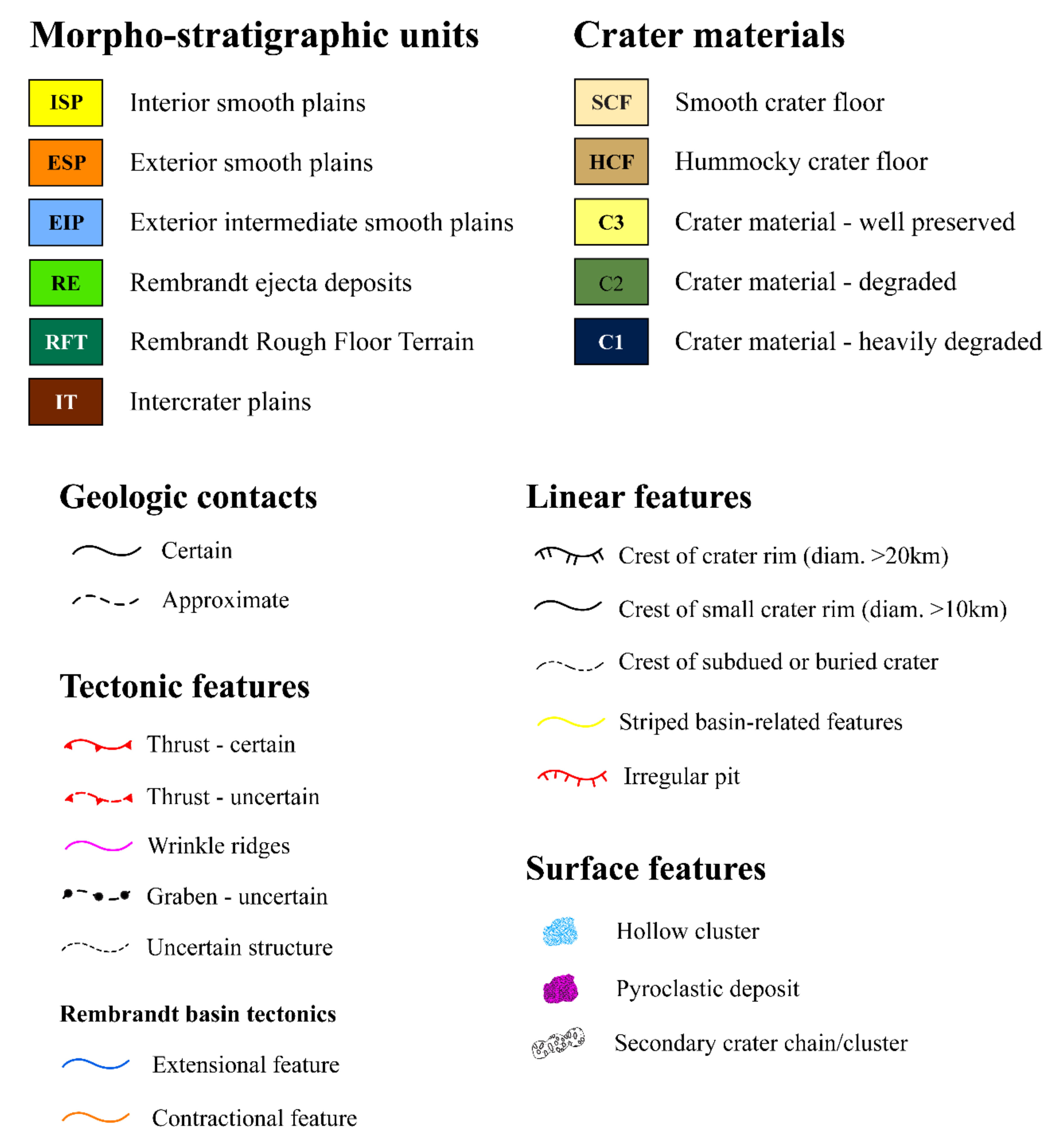
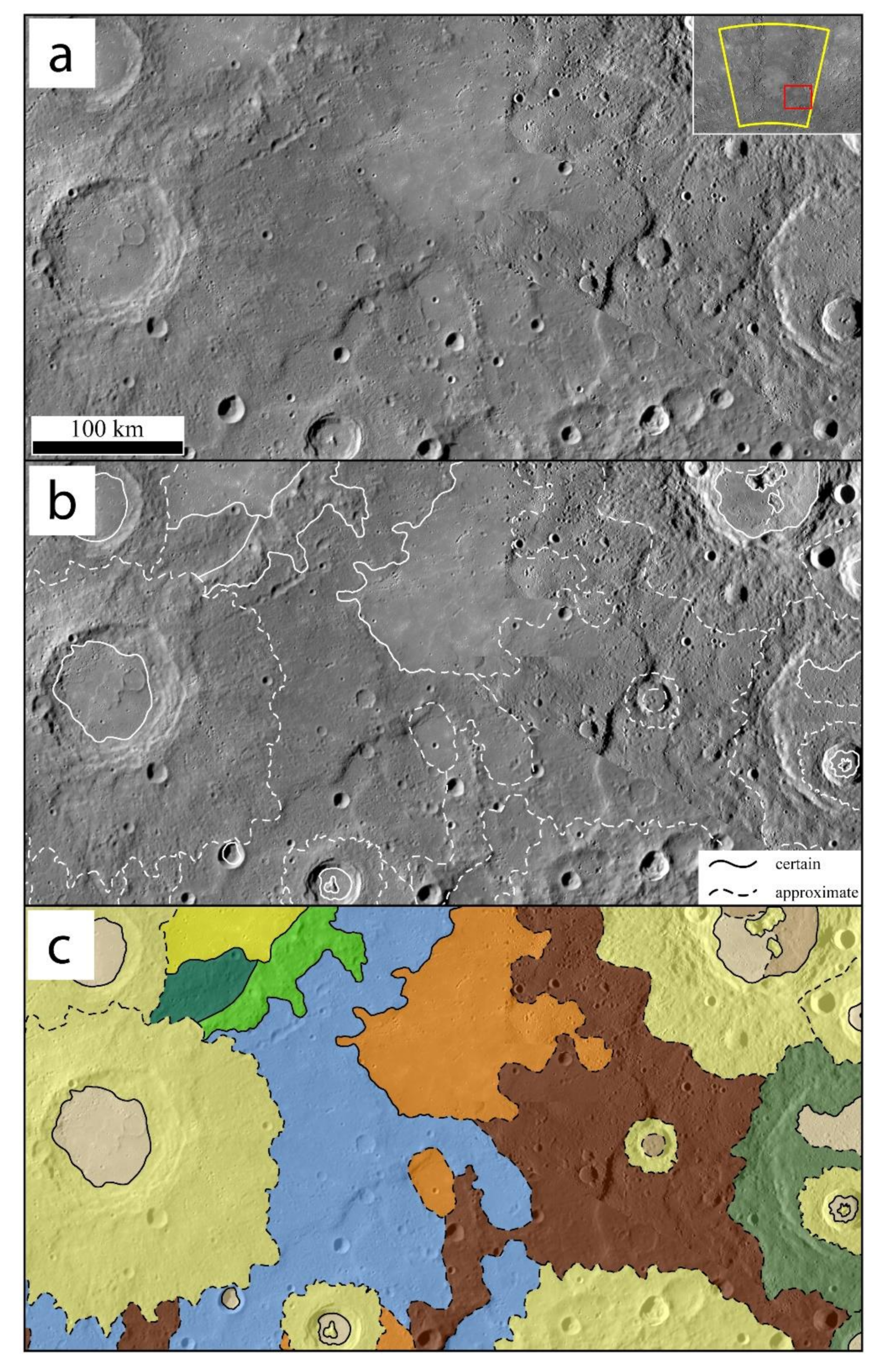
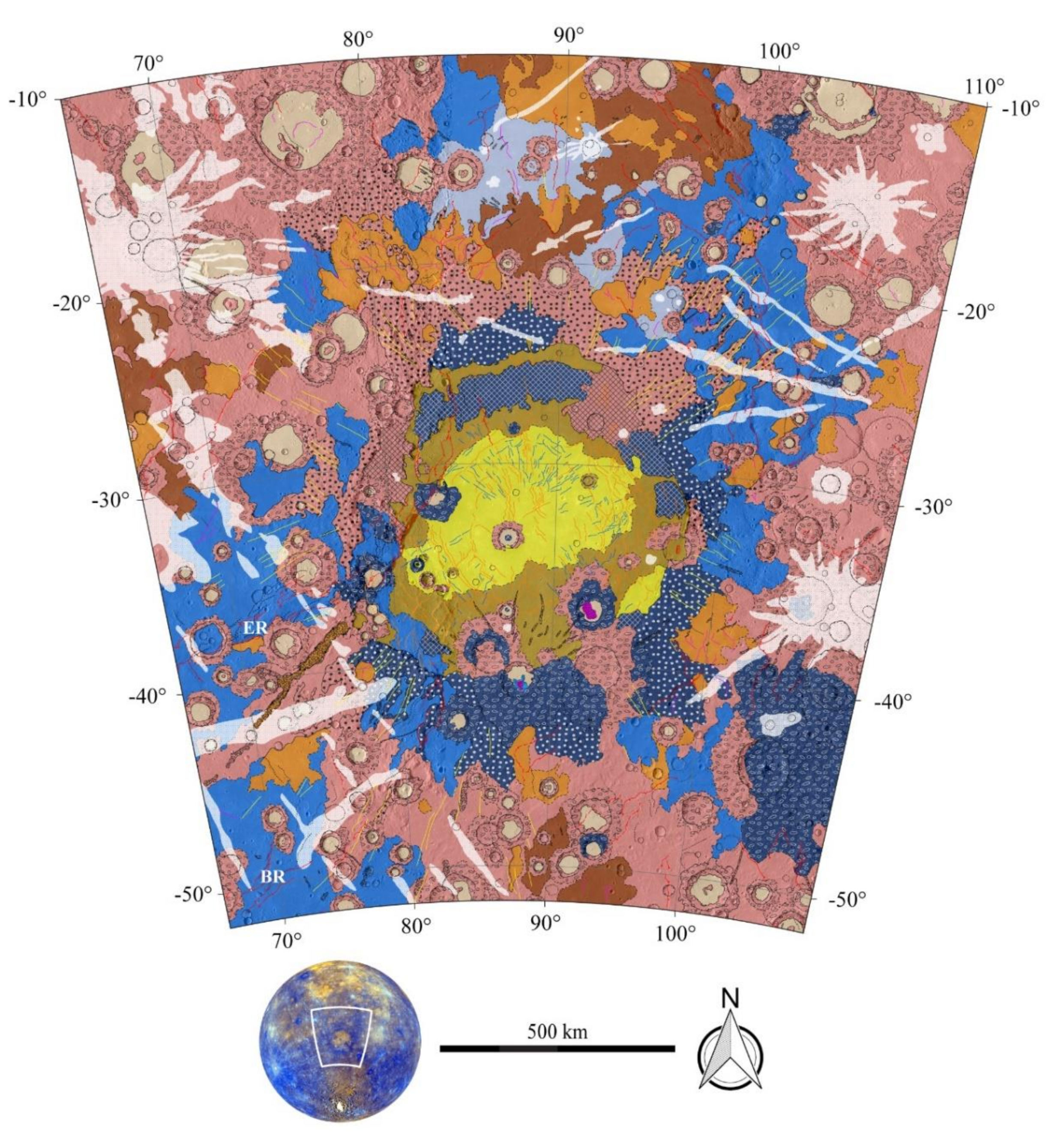
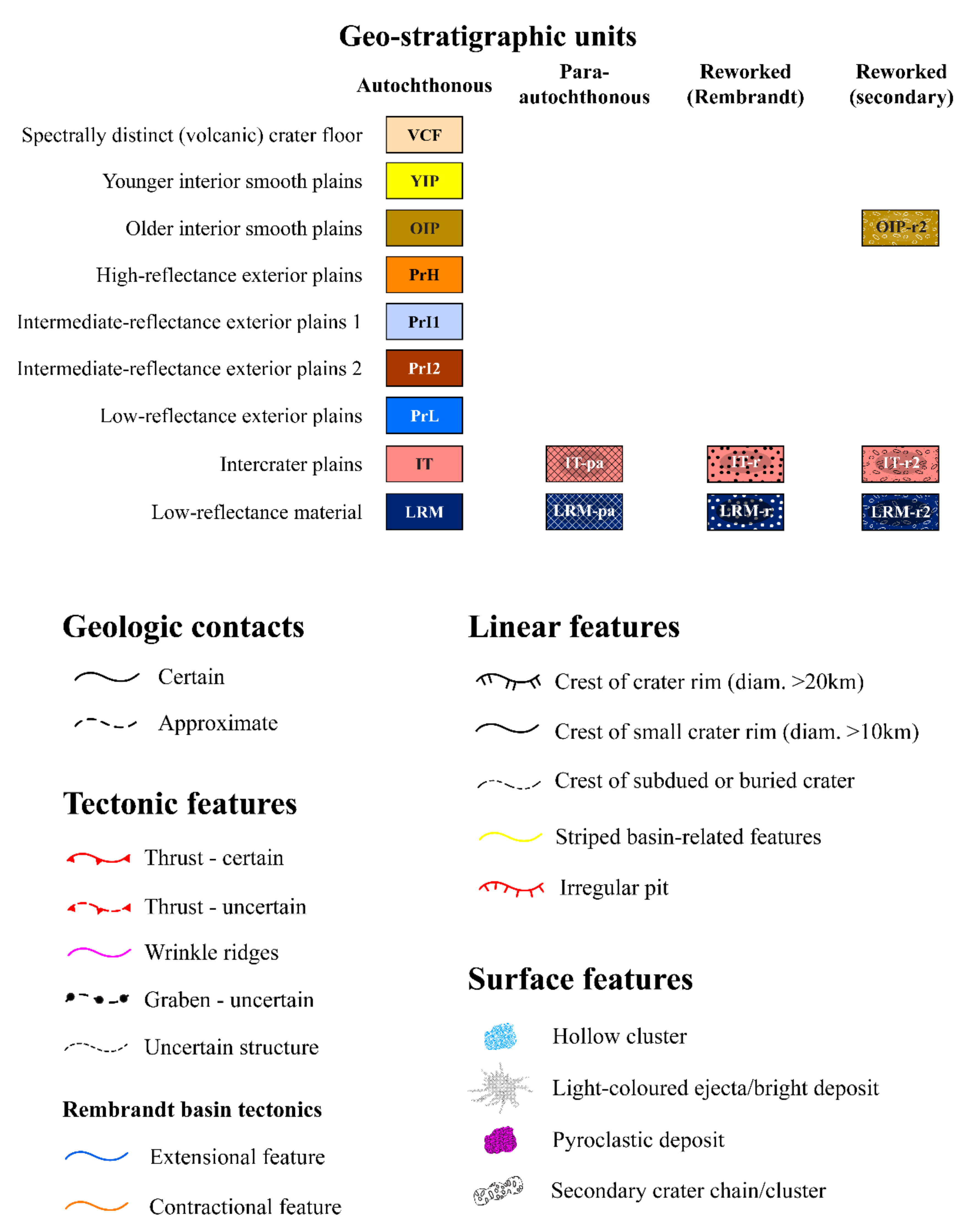
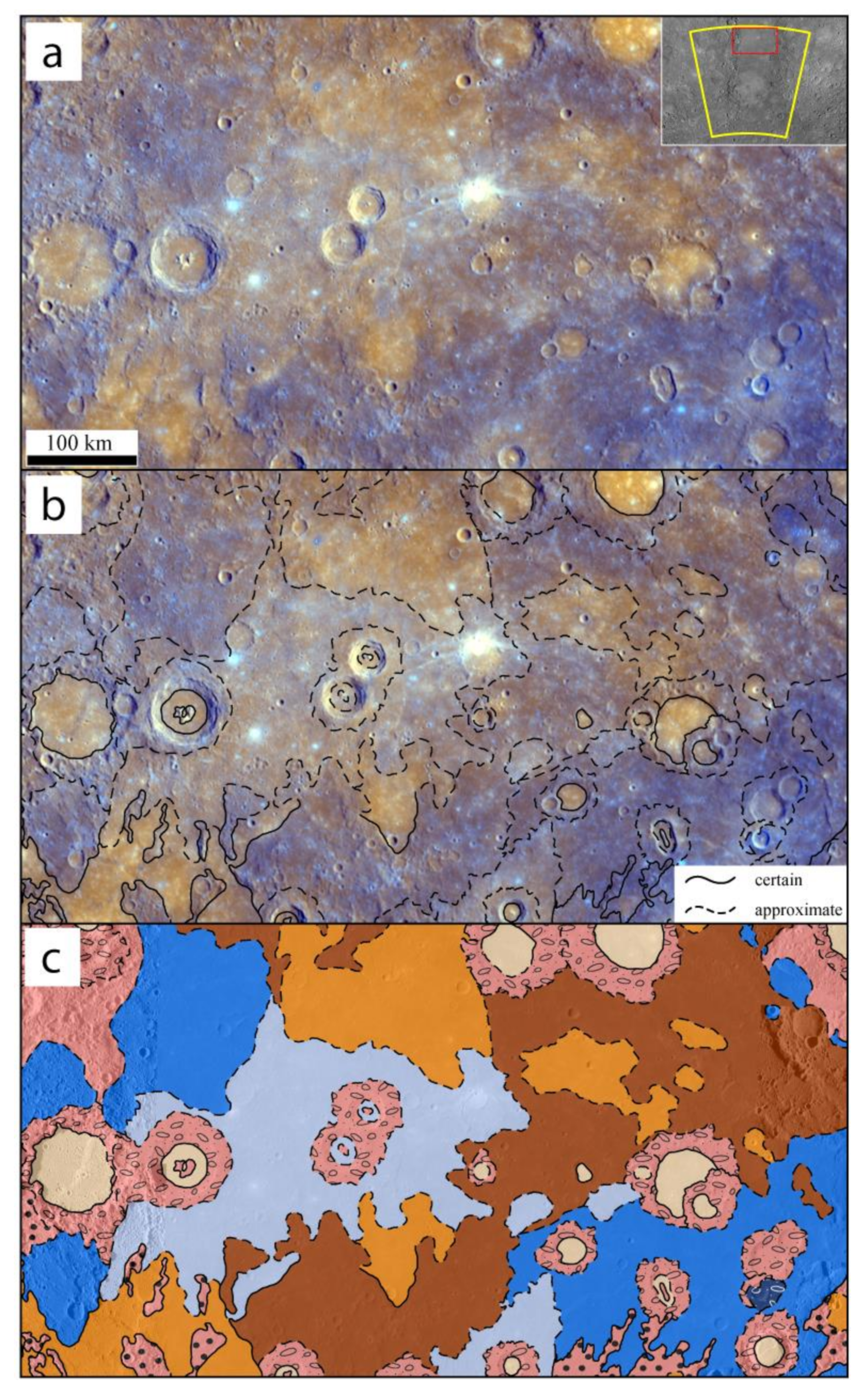




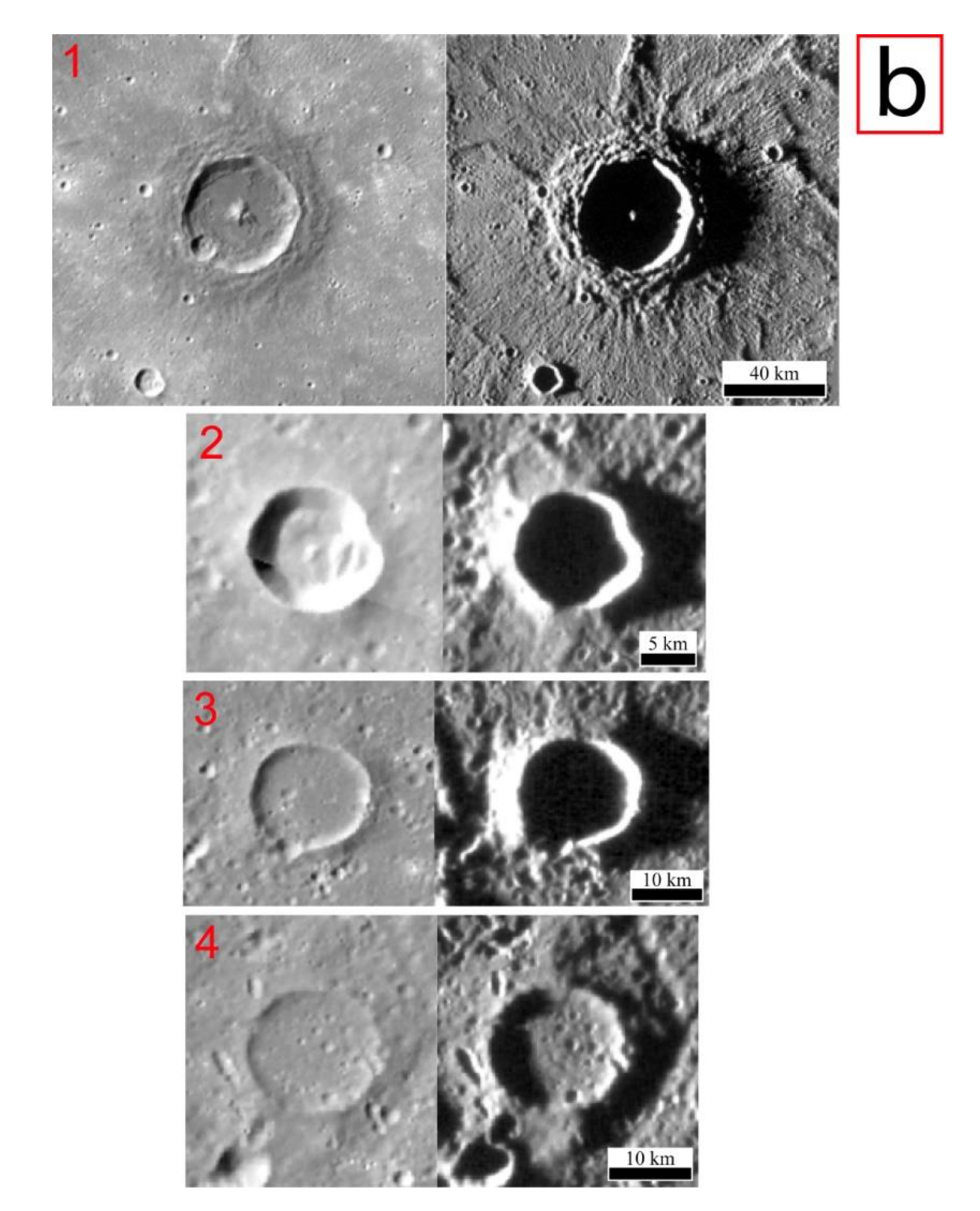
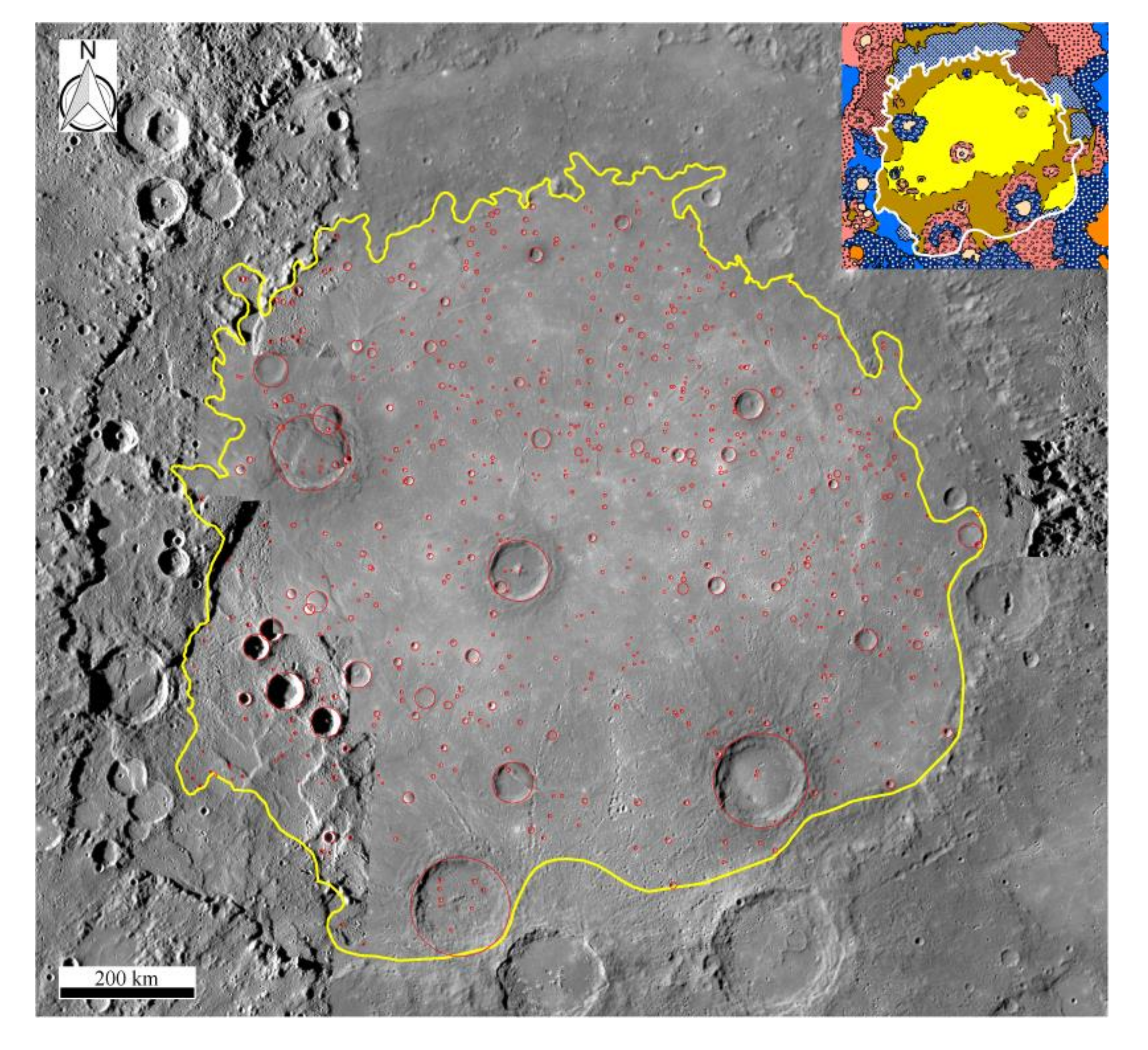
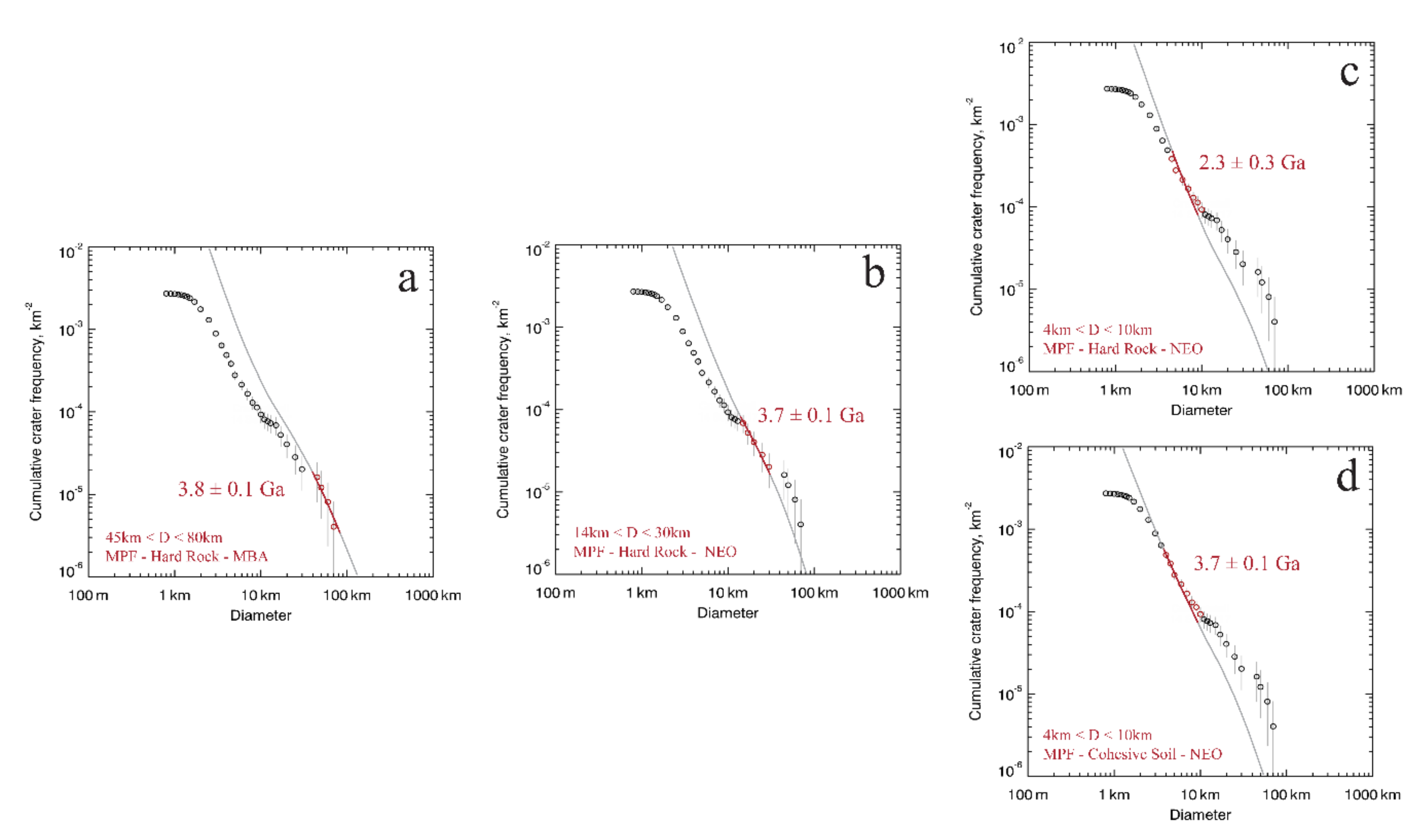

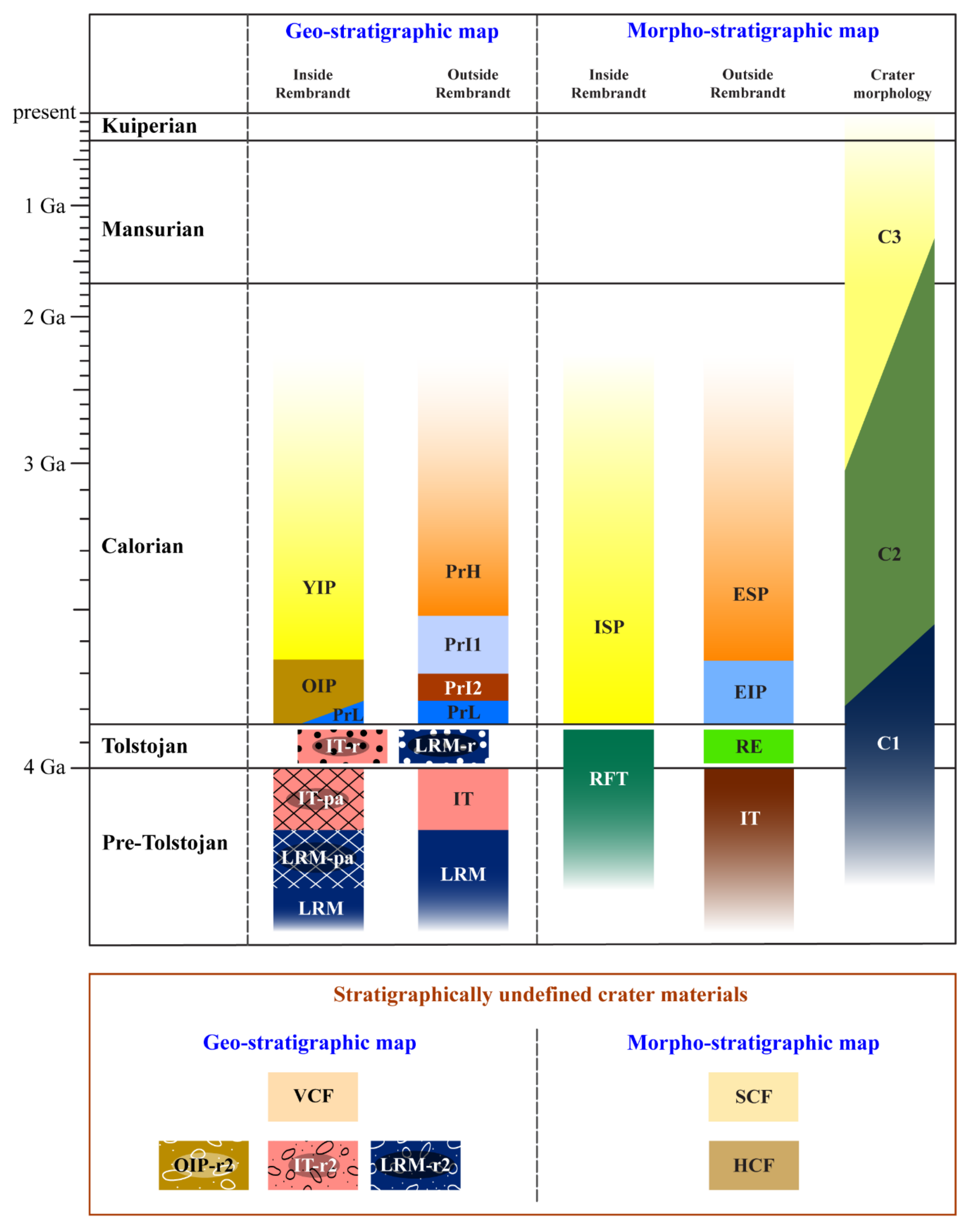
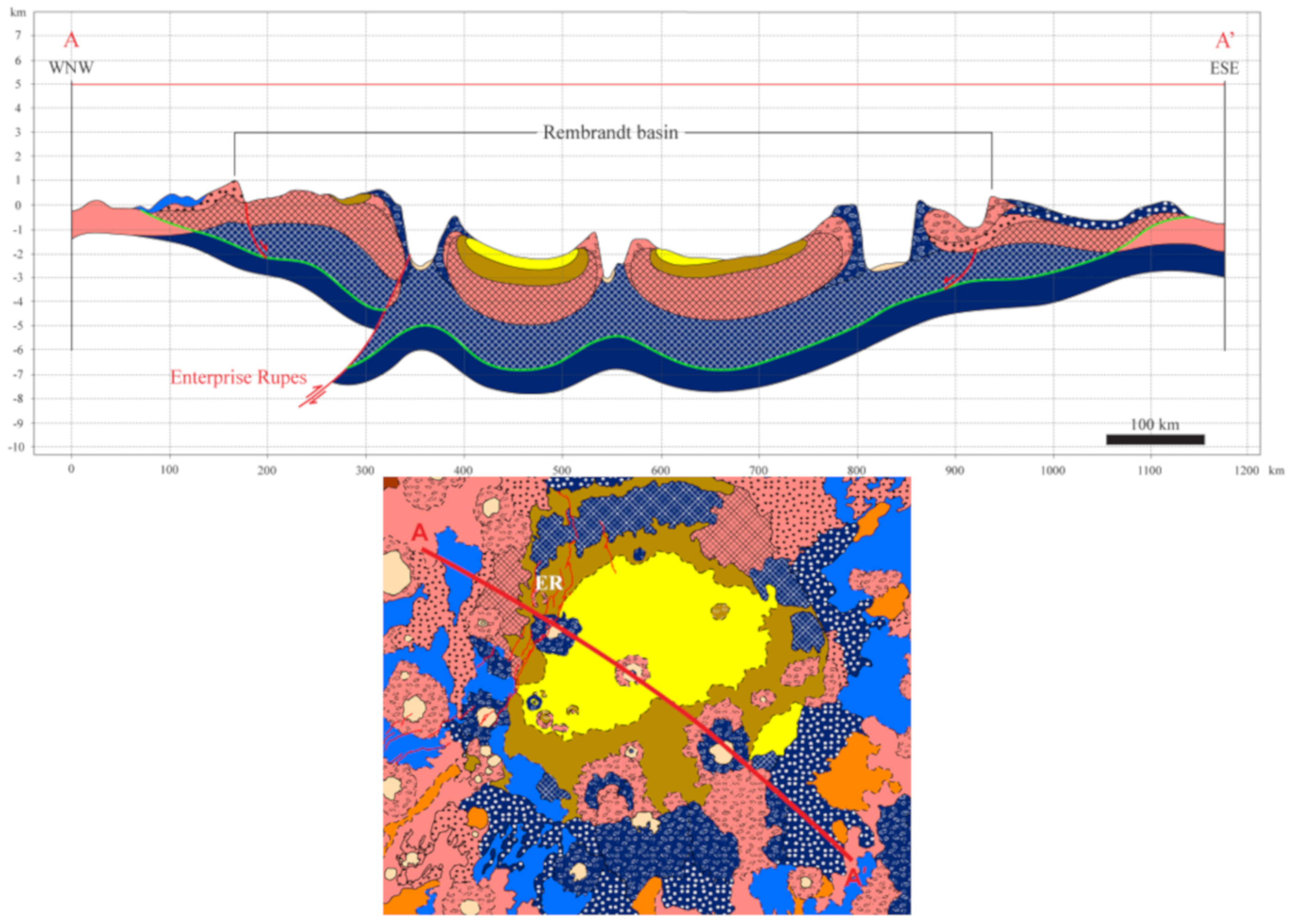
| Crater | Dr Measured | Maximum Excavation Depth 1 | Excavated Unit 2 | Minimum Thickness of Smooth Plains | Minimum Depth of Dark Material 3 |
|---|---|---|---|---|---|
| 1 | 44 | 3.00 | DM | <3.0 | |
| 2 | 11 | 0.84 | BM | >0.84 | |
| 3 | 13.5 | 1.01 | BM | >1.01 | |
| 4 | 13.5 | 1.01 | BM | >1.01 | |
| 5 | 21 | 1.52 | BM | >1.52 | |
| 6 | 13.5 | 1.01 | BM | >1.01 | |
| 7 | 10 | 0.77 | BM | >0.77 | |
| 8 | 21 | 1.52 | DM | <1.52 | |
| 9 | 31 | 2.18 | DM | <2.18 | |
| 10 | 6.5 | 0.52 | BM | >0.52 | |
| 11 | 10 | 0.77 | DM | <0.77 | |
| 12 | 11 | 0.84 | BM | >0.84 | |
| 13 | 59 | 3.94 | DM | <3.94 | |
| 14 | 24.5 | 1.75 | DM | <1.75 | |
| 15 | 39 | 2.05 | DM | <2.05 | |
| 16 | 17 | 1.25 | BM | >1.25 | |
| 17 | 19 | 1.39 | DM | <1.39 | |
| 18 | 9 | 0.70 | BM | >0.70 | |
| 19 | 9 | 0.70 | BM | >0.70 | |
| 20 | 8.5 | 0.66 | BM | >0.66 | |
| 21 | 23 | 1.65 | DM | <1.65 | |
| 22 | 73 | 4.79 | DM | <4.79 | |
| 23 | 79 | 5.15 | DM | <5.15 | |
| 24 | 67 | 4.42 | DM | <4.42 | |
| 25 | 16 | 1.18 | DM | <1.18 |
| Crater | Average Diameter | Measured Rim Height | σ Measured Rim Height | Predicted Rim Height | σ Predicted Rim Height | Plains Thickness | σ Plains Thickness |
|---|---|---|---|---|---|---|---|
| 1 a | 43.4 | 0.705 | 0.081 | 0.718 | 0.06 | 0.01 (≈ 0.00) | 0.14 |
| 2 b | 11.3 | 0.063 | 0.028 | 0.360 | 0.01 * | 0.30 * | 0.04 |
| 0.493 | 0.06 ** | 0.43 ** | 0.09 | ||||
| 3 | 13.5 | 0.075 | 0.028 | 0.518 | 0.06 | 0.44 | 0.09 |
| 4 | 13.7 | 0.058 | 0.017 | 0.520 | 0.06 | 0.46 | 0.08 |
© 2020 by the authors. Licensee MDPI, Basel, Switzerland. This article is an open access article distributed under the terms and conditions of the Creative Commons Attribution (CC BY) license (http://creativecommons.org/licenses/by/4.0/).
Share and Cite
Semenzato, A.; Massironi, M.; Ferrari, S.; Galluzzi, V.; Rothery, D.A.; Pegg, D.L.; Pozzobon, R.; Marchi, S. An Integrated Geologic Map of the Rembrandt Basin, on Mercury, as a Starting Point for Stratigraphic Analysis. Remote Sens. 2020, 12, 3213. https://doi.org/10.3390/rs12193213
Semenzato A, Massironi M, Ferrari S, Galluzzi V, Rothery DA, Pegg DL, Pozzobon R, Marchi S. An Integrated Geologic Map of the Rembrandt Basin, on Mercury, as a Starting Point for Stratigraphic Analysis. Remote Sensing. 2020; 12(19):3213. https://doi.org/10.3390/rs12193213
Chicago/Turabian StyleSemenzato, Andrea, Matteo Massironi, Sabrina Ferrari, Valentina Galluzzi, David A. Rothery, David L. Pegg, Riccardo Pozzobon, and Simone Marchi. 2020. "An Integrated Geologic Map of the Rembrandt Basin, on Mercury, as a Starting Point for Stratigraphic Analysis" Remote Sensing 12, no. 19: 3213. https://doi.org/10.3390/rs12193213
APA StyleSemenzato, A., Massironi, M., Ferrari, S., Galluzzi, V., Rothery, D. A., Pegg, D. L., Pozzobon, R., & Marchi, S. (2020). An Integrated Geologic Map of the Rembrandt Basin, on Mercury, as a Starting Point for Stratigraphic Analysis. Remote Sensing, 12(19), 3213. https://doi.org/10.3390/rs12193213






